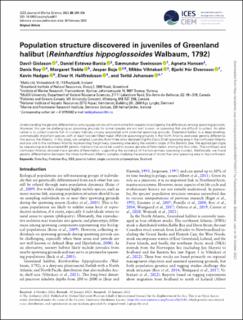| dc.contributor.author | Gíslason, Davíð | |
| dc.contributor.author | Estévez-Barcia, Daniel | |
| dc.contributor.author | Sveinsson, Sæmundur | |
| dc.contributor.author | Hansen, Agneta | |
| dc.contributor.author | Roy, Denis | |
| dc.contributor.author | Treble, Margaret | |
| dc.contributor.author | Boje, Jesper | |
| dc.contributor.author | Vihtakari, Mikko | |
| dc.contributor.author | Elvarsson, Bjarki Þór | |
| dc.contributor.author | Hedges, Kevin | |
| dc.contributor.author | Hallfredsson, Elvar Halldor | |
| dc.contributor.author | Johansen, Torild | |
| dc.date.accessioned | 2023-10-05T11:17:46Z | |
| dc.date.available | 2023-10-05T11:17:46Z | |
| dc.date.created | 2023-09-14T10:55:47Z | |
| dc.date.issued | 2023 | |
| dc.identifier.citation | ICES Journal of Marine Science. 2023, 80 (4), 889-896. | en_US |
| dc.identifier.issn | 1054-3139 | |
| dc.identifier.uri | https://hdl.handle.net/11250/3094470 | |
| dc.description.abstract | Understanding the genetic differentiation among populations of most marine fish requires investigating the differences among spawning grounds. However, this can be challenging as spawning grounds for some species are not well known, or spawning fish are difficult to collect. An alternative is to collect juvenile fish in nursery habitats closely associated with potential spawning grounds. Greenland halibut is a deep-dwelling, commercially important species with at least two identified major offshore spawning grounds in the North Atlantic and weak genetic differentiation across the Atlantic. In this study, we sampled juveniles from three sites representing the Davis Strait spawning area in the northwest Atlantic and one site in the northeast Atlantic representing the primary spawning area along the western slope of the Barents Sea. We applied genotype by sequencing and discovered 90 genetic markers that could be used to assess genetic differentiation among the four sites. The northeast and northwest Atlantic showed major genetic differentiation, supporting the existence of the two primary spawning clusters. Additionally, we found genetic differentiation between the three northwest Atlantic samples implying the existence of more than one spawning area in the northwest. | en_US |
| dc.language.iso | eng | en_US |
| dc.title | Population structure discovered in juveniles of Greenland halibut (Reinhardtius hippoglossoides Walbaum, 1792) | en_US |
| dc.title.alternative | Population structure discovered in juveniles of Greenland halibut (Reinhardtius hippoglossoides Walbaum, 1792) | en_US |
| dc.type | Peer reviewed | en_US |
| dc.type | Journal article | en_US |
| dc.description.version | publishedVersion | en_US |
| dc.source.pagenumber | 889-896 | en_US |
| dc.source.volume | 80 | en_US |
| dc.source.journal | ICES Journal of Marine Science | en_US |
| dc.source.issue | 4 | en_US |
| dc.identifier.doi | 10.1093/icesjms/fsad011 | |
| dc.identifier.cristin | 2175018 | |
| dc.relation.project | Havforskningsinstituttet: 15179 | en_US |
| cristin.ispublished | true | |
| cristin.fulltext | original | |
| cristin.qualitycode | 2 | |
